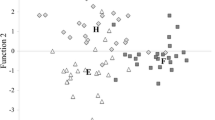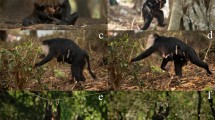Abstract
Close association between an anoestrous female at the time of lactation and adult male(s) is relatively rare in mammals, but common in baboons (Papio hamadryas subsp.). The functional significance of these “friendships” remains unclear, however. In chacma baboons (P. h. griseipes), friendships are a counter-strategy to infanticide by immigrant males. Experimental playback of female distress calls in chacma baboons revealed that male friends are more motivated to protect females and infants than are control males. Olive baboons (P. h. anubis) also exhibit friendships, but infanticide is rare, suggesting that friendships provide females with protection from non-lethal aggression (anti-harassment hypothesis) or serve to promote male–infant bonds that later benefit the maturing juvenile (future male caretaker hypothesis). We replicated these playback experiments on a group of olive baboons to test between these hypotheses and to evaluate if the lower costs of non-lethal harassment lessens male protective responsiveness relative to protection from (more costly) infanticide. Spatial data revealed that most lactating females had one to four friend males. Relative to non-friends, friend dyads were characterized by higher rates of allogrooming and infant handling, but less agonism. Female rank was correlated with the number of male friends. Just as in chacma baboons, playback of female screams elicited stronger responses from male friends than control males in support the anti-harassment hypothesis. Compared to the chacma baboon, male olive baboons appeared to exhibit similarly high levels of protective solicitude for female friends although they protect against non-lethal harassment rather than infanticide.




Similar content being viewed by others
References
Altmann J (1974) Observational study of behavior: sampling methods. Behaviour 49:227–267
Altmann J (1980) Baboon mothers and infants. University of Chicago Press, Chicago
Anderson CM (1983) Levels of social organization and male–female bonding in the genus Papio. Am J Phys Anthropol 60:15–22
Arnqvist G, Rowe L (2005) Sexual conflict. Princeton University Press, Princeton
Avise JC (1996) Three fundamental contributions of molecular genetics to avian ecology and evolution. Ibis 138:16–25
Bergman TJ, Beehner JC, Cheney DL, Seyfarth RM (2003) Hierarchical classification by rank and kinship in baboons. Science 302:1234–1236
Birkhead TR, Møller AP (1992) Sperm competition in birds: evolutionary causes and consequences. Academic, London
Burton FD (1972) The integration of biology and behavior in the socialization of Macaca sylvanus of Gibraltar. In: Poirier F (ed) Primate socialization. Random House, New York, pp 29–62
Busse CD (1984) Tail raising by baboon mothers toward immigrant males. Am J Phys Anthropol 64:255–262
Busse CD, Hamilton WJ III (1981) Infant carrying by male chacma baboons. Science 212:1281–1283
Cheney DL, Seyfarth RM (1990) How monkeys see the world: inside the mind of another species. The University of Chicago Press, Chicago
Cheney DL, Seyfarth RM, Fischer J, Beehner J, Bergman T, Johnson SE, Kitchen DM, Palombit RA, Rendall D, Silk JB (2004) Factors affecting reproduction and mortality among baboons in the Okavango Delta, Botswana. Int J Primatol 25:401–428
Collins DA (1986) Interactions between adult male and infant yellow baboons (Papio c. cynocephalus). Anim Behav 34:430–443
Collins DA, Busse CD, Goodall J (1984) Infanticide in two populations of savannah baboons. In: Hausfater G, Hrdy SB (eds) Infanticide: a comparative and evolutionary perspective. Aldine, New York, pp 193–215
Darwin C (1871) The descent of man and selection in relation to sex. Random House, modern library edition, New York
Gouzoules S, Gouzoules H, Marler P (1984) Rhesus monkey, Macaca mulatta, screams: representational signalling in the recruitment of agonistic aid. Anim Behav 32:182–193
Henzi SP, Barrett L (2003) Evolutionary ecology, sexual conflict and behavioral differentiation among baboon populations. Evol Anthropol 12:217–230
Hinde RA (1977) On assessing the bases of partner preferences. Behaviour 62:1–9
Marler P, Evans CS, Hauser MD (1992) Animal signals: motivational, referential, or both? In: Papousek H, Jürgens U, Papousek M (eds) Nonverbal vocal communication: comparative and development approaches. Cambridge University Press, New York, pp 66–86
Melnick DJ, Pearl MC (1987) Cercopithecines in multimale groups: genetic diversity and population structure. In: Smuts BB, Cheney DL, Seyfarth RM, Wrangham RW, Struhsaker TT (eds) Primate societies. University of Chicago Press, Chicago, pp 121–134
Møller AP, Cuervo JJ (2000) The evolution of paternity and paternal care in birds. Behav Ecol 11:472–485
Palombit RA (2000) Male–female social relationships and infanticide in animals. In: van Schaik CP, Janson CH (eds) Male infanticide and its implications. Cambridge University Press, Cambridge, pp 239–268
Palombit RA (2006) Contrasts and similarities in male–female friendships in wild chacma baboons (Papio hamadryas ursinus) and olive baboons (Papio h. anubis). International Journal of Primatology 27(Supplement 1):534
Palombit, RA (2008) Friendships with males: a female counterstrategy to infanticide in the Okavango chacma baboons. In: Muller MN, Wrangham RW (eds) Male aggression against females in primates. Harvard University Press, Cambridge, MA (in press)
Palombit RA (2003) Male infanticide in wild savanna baboons: adaptative significance and intraspecific variation. In: Jones C (ed) Sexual selection and reproductive competition in primates: new perspectives and directions. Am Soc Primatol, Norman (OK), pp 367–411
Palombit RA, Seyfarth RM, Cheney DL (1997) The adaptive value of friendships to female baboons: experimental and observational evidence. Anim Behav 54:599–614
Palombit RA, Cheney DL, Seyfarth RM (2001) Female–female competition for male ‘friends’ in wild chacma baboons, Papio cynocephalus ursinus. Anim Behav 61:1159–1171
Ransom TW, Ransom BS (1971) Adult male–infant relations among baboons (Papio anubis). Folia Primatol 16:179–195
van Schaik CP, Dunbar RIM (1990) The evolution of monogamy in large primates: a new hypothesis and some crucial tests. Behaviour 115:30–62
van Schaik CP, Paul A (1996) Male care in primates: does it ever reflect paternity? Evol Anthropol 5:152–156
Seyfarth RM (1978) Social relationships among adult male and female baboons, II. Behaviour throughout the female reproductive cycle. Behaviour 64:227–247
Smuts BB (1985) Sex & friendship in baboons. Aldine publishing company, New York
Smuts BB, Nicolson N (1989) Reproduction in wild female baboons. Am J Primatol 19:229–246
Stein DM (1984) Ontogeny of infant–adult male relationships during the first year of life for yellow baboons (Papio cynocephalus). In: Primate paternalism. Van Nostrand Reinhold, New York, pp 213–243
Strum SC (1975) Life with the Pumphouse Gng: new insights into baboon behavior. Natl Geogr 147:672–691
Trivers RL (1972) Parental investment and sexual selection. In: Campbell B (ed) Sexual selection and the descent of man. Aldine-Atherton, Chicago, pp 136–179
Weingrill T (2000) Infanticide and the value of male–female relationships in mountain chacma baboons. Behaviour 137:337–359
Young TP, Kinua D, Okello BN, Palmer TM (1998) KLEE: A long-term multi-species herbivore exclusion experiment in Laikipia. Afr J Range Forage Sci 14:94–102
Acknowledgments
We thank the Office of the President of Kenya, the National Museums and its Director General, Dr. I. Farah, and the Institute of Primate Research (Nairobi) for sponsorship and permission to conduct research in Laikipia district. We are grateful to John Ruggieri and Patrick Leparleen for allowing us to conduct research in the Segera area and to Philip and Janine Valentine for logistical assistance. We thank Stephen Karimi, Mohammed Abdi, and Francis Kokoe for their field assistance. We also thank Kristin Palombit for her significant contribution to maintaining the project. The research was supported by grants to RAP from the National Science Foundation (BCS 0117213), the L.S.B. Leakey Foundation, the Wenner–Gren Foundation, Rutgers University, and the Center for Human Evolutionary Studies (CHES, Rutgers University). The observations and experiments of that study comply with the current laws of Kenya.
Author information
Authors and Affiliations
Corresponding author
Additional information
Communicated by D. Watts
Rights and permissions
About this article
Cite this article
Lemasson, A., Palombit, R.A. & Jubin, R. Friendships between males and lactating females in a free-ranging group of olive baboons (Papio hamadryas anubis): evidence from playback experiments. Behav Ecol Sociobiol 62, 1027–1035 (2008). https://doi.org/10.1007/s00265-007-0530-z
Received:
Revised:
Accepted:
Published:
Issue Date:
DOI: https://doi.org/10.1007/s00265-007-0530-z




